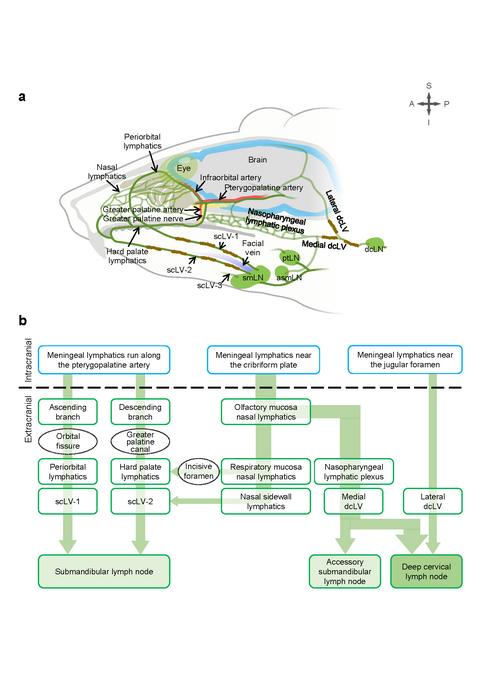A groundbreaking study from the Institute for Basic Science (IBS) unveils a revolutionary, non-invasive technique to amplify the brain’s intrinsic waste clearance mechanism. This discovery promises new therapeutic avenues for age-related neurodegenerative disorders by enhancing cerebrospinal fluid (CSF) drainage using gentle mechanical stimulation instead of conventional drug therapies or invasive surgeries.
In a publication appearing in the prestigious journal Nature, the research team led by KOH Gou Young, Director of the IBS Center for Vascular Research, has meticulously elucidated a novel cerebrospinal fluid drainage route. Utilizing genetically modified animal models tagged with fluorescent tracers, the scientists identified previously uncharted lymphatic vessels positioned under the facial skin. These vessels connect the brain’s outer surfaces to superficial cervical lymph nodes in the neck, offering a fresh perspective on CSF clearance pathways critical for brain homeostasis.
The human brain produces metabolic waste at an extraordinary pace compared to other organs, necessitating highly efficient clearance systems to preserve neural function. Cerebrospinal fluid, a clear and nourishing liquid bathing the brain and spinal cord, plays an essential role in this cleansing process by transporting waste, including harmful amyloid-β and tau proteins implicated in Alzheimer’s disease and other dementias. Unfortunately, these drainage mechanisms progressively deteriorate with age, exacerbating cognitive decline and neurodegeneration.
.adsslot_HhzlUSaQEs{width:728px !important;height:90px !important;}
@media(max-width:1199px){ .adsslot_HhzlUSaQEs{width:468px !important;height:60px !important;}
}
@media(max-width:767px){ .adsslot_HhzlUSaQEs{width:320px !important;height:50px !important;}
}
ADVERTISEMENT
Breaking this impasse, the newly identified lymphatic network under the facial skin offers an accessible interface for therapeutic intervention. Aging animal models revealed that while many drainage pathways succumb to degeneration, these superficial lymphatics persist with remarkable functionality, preserving their fluid drainage capacity despite advancing age. This resilience marks them as prime candidates for enhancing CSF clearance in elderly populations.
Harnessing this insight, the researchers engineered a force-regulated mechanical stimulator—a handheld device designed to apply precise and gentle compressive and stroking motions to the skin surface. Application of this device to aged mice reinstated their CSF drainage efficiency to levels reminiscent of youthful specimens, without disturbing the natural rhythmic contractions of lymphatic vessels, a feat that underscores the method’s delicacy and effectiveness.
Neurovascular physiologist YOON Jin-Hui, co-first author of the study, emphasizes the potential of this non-invasive mechanical approach to revolutionize treatments for neurological disorders. Ongoing research aims to decipher alterations of this newly outlined drainage pathway in human brain disease cohorts and to evaluate the therapeutic efficacy of mechanical stimulation across various clinical scenarios.
From a mechanistic standpoint, the study sheds light on the pivotal role of lymphatic vessels in brain waste disposal—a function historically undervalued in neuroscience. The ability to physically enhance CSF movement through superficial lymphatics could mitigate protein deposition and neuroinflammation characteristic of Alzheimer’s and related dementias, potentially delaying disease onset or progression.
The prospect of wearable or clinical devices based on this mechanical stimulation technique offers a non-pharmacological, low-risk intervention to support cognitive health in aging populations. Such innovations could democratize brain health maintenance, making preventive therapies accessible and acceptable across diverse patient groups.
As the research community awaits further translational studies, the findings presented by the IBS team mark a milestone in neurovascular biology and therapeutic innovation. They not only complete a crucial map of brain waste drainage but also redefine how non-invasive technologies can harness the body’s lymphatic architecture to combat debilitating neurological disorders.
The publication of this study in Nature on June 4, 2025, underscores its scientific rigor and potential global impact. Funded by the Institute for Basic Science, this work stands as a testament to the power of interdisciplinary research in addressing some of the most pressing challenges in brain health and aging.
Subject of Research: Animals
Article Title: Increased CSF drainage by non-invasive manipulation of cervical lymphatics
News Publication Date: 4-Jun-2025
Web References: http://dx.doi.org/10.1038/s41586-025-09052-5
Image Credits: Institute for Basic Science
Keywords: Lymphatic system, Cerebrospinal fluid, Brain, Central nervous system, Nervous system, Neurological disorders, Neurodegenerative diseases, Nasopharynx, Dementia, Cognitive disorders, Vascular biology, Blood vessels
Tags: age-related cognitive decline solutionsAlzheimer’s disease waste removalbrain homeostasis mechanismsbrain waste clearance enhancementcerebrospinal fluid drainage techniquefluorescent tracers in neurosciencegentle mechanical stimulation for CSFinnovative approaches to dementia treatmentInstitute for Basic Science researchlymphatic vessels in brainneurodegenerative disorder therapiesnon-invasive brain treatment





